Challenging the Consensus for Rising Interest Rates
Interest-Rates / US Interest Rates Feb 05, 2014 - 05:07 PM GMTBy: John_Mauldin
 One of the most universal consensus calls in the markets today is that interest rates are destined to rise. Thirteen out of 13 major investment banks all think that interest rates for global fixed-income will rise this year. I get nervous when everybody is on the same side of the boat. And so does my good friend and business partner Niels Jensen of Absolute Return Partners in London. This week’s Outside the Box is another of his thoughtful essays, giving us five reasons why interest rates may in fact go down this year. That is not to say that we don't both agree that rates have to go back up eventually, but to us the timing is not so obvious as it is to the major investment banks. Rather than tip his thunder, I’ll let Niels advocate for his position. (And you can see more of his consistently excellent work at www.arpinvestments.com.)
One of the most universal consensus calls in the markets today is that interest rates are destined to rise. Thirteen out of 13 major investment banks all think that interest rates for global fixed-income will rise this year. I get nervous when everybody is on the same side of the boat. And so does my good friend and business partner Niels Jensen of Absolute Return Partners in London. This week’s Outside the Box is another of his thoughtful essays, giving us five reasons why interest rates may in fact go down this year. That is not to say that we don't both agree that rates have to go back up eventually, but to us the timing is not so obvious as it is to the major investment banks. Rather than tip his thunder, I’ll let Niels advocate for his position. (And you can see more of his consistently excellent work at www.arpinvestments.com.)
It’s been a busy week here in Dallas, but then aren't they all lately? But it’s good to be busy at home for the next few weeks. Lots of material to be written and edited, plans to be made, and trips to be scheduled, of course. My current sedentary lifestyle will soon revert to its normal peripatetic frenzy, but it’s good to give the body a bit of rest. Enjoy your week.
Your getting ready for some left-over Super Bowl chili analyst,
John Mauldin, Editor Outside the Box JohnMauldin@2000wave.comStay Ahead of the Latest Tech News and Investing Trends...
Click here to sign up for Patrick Cox’s free daily tech news digest.
Each day, you get the three tech news stories with the biggest potential impact.
Challenging the Consensus
"The noble title of 'dissident' must be earned rather than claimed; it connotes sacrifice and risk rather than mere disagreement."
Christopher Hitchens, Polemicist
Herd mentality is one of the strongest and most powerful human instincts. Humans take great comfort from walking the same path as others have walked before them, and nowhere is this more evident than in the field of investments. Most investors are simply incapable of disregarding the consensus when making investment decisions, if for no other reason than because 'being out there on your own' is associated with considerable career risk (I wrote about this back in October 2012 – see here).
I consider myself a contrarian investor. Not a contrarian for the sake of being a contrarian but a contrarian nevertheless. My inclination to go against the prevailing view is based on one very simple piece of knowledge acquired through 30 years of trial and error. When an investor states that he is bullish, he is more often than not close to being fully invested, hence he has used most, if not all, of his dry powder. Obviously, the more people who find themselves in this situation, the less purchasing power there is on an aggregate basis. At this point the market is at or near its peak. Precisely the opposite is the case when most investors are bearish. They have sold most if not all of their holdings, at which point the market is more likely to go up than down.
This way of thinking is frequently challenged by people (often academics) who argue that it cannot be that way, because investing is a zero sum game. We cannot all sell out at the same time, as someone has to own those bonds, or so the argument goes. Whilst theoretically correct, this view fails to take into account the distinction between core and marginal investors. Whilst marginal investors (e.g. private investors, hedge funds) can, and do, move freely between asset classes, core investors (e.g. pension funds, sovereign wealth funds) are at least partially restricted in their movements. Such limitations ensure that, in practice, investing is not a zero sum game.
Now, when I look at financial markets going into 2014, I cannot recall ever having come across a more one-sided view than the one which prevails. The consensus view on bonds is overwhelmingly bearish while pretty much everyone is bullish on equities – or at least they were until EM equities began to fall out of bed. Barry Ritholtz (The Big Picture blog) has done a great job of assembling, and presenting, the sell-side view in a simple to understand format (chart 1).
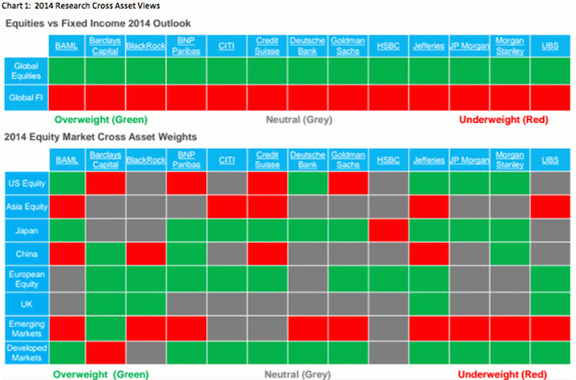
Source: http://www.ritholtz.com/blog/2014/01/surprising-consensus-on-asset/
Some may argue that the sell-side is always bullish on equities, and while that is not a million miles away from the truth, this year is still uniquely one-sided. And it is certainly not the case that the sell-side is always uniformly negative on the outlook for interest rates. As far as the bond market is concerned, the 2014 consensus is a major outlier, and that is precisely what has piqued my interest. It is much more difficult to obtain reliable information on the buy-side consensus. Suffice to say that none of the information I have at hand has given me any reason to speculate that the buy-side view differs materially from that of the sell-side. See, for example, the recently updated policy portfolio for the Harvard University Endowment here.
Five reasons you may want to change your bearish view
In the December 2013 Absolute Return Letter ('Squeaky Bum Time') I discussed our 2014 expectations for equities – see here. This month I will focus on the outlook for interest rates and challenge the prevailing wisdom – i.e. that rates are destined to rise as 2014 progresses. I am not suggesting that the consensus view will definitely prove wrong in 2014; however, I can think of at least five plausible reasons why many may end up with a little bit of egg on their faces as interest rates fall before they rise.
I agree with the view shared by many that, in the long term, as economic conditions normalise, interest rates will almost certainly rise. I cannot possibly disagree with that. The words to pay attention to, though, are 'long term'. In the meantime, 2014 may contain one or two surprises, effectively delaying the bond bear market.
Now to those reasons, and in no particular order:
- The emerging market crisis escalates further;
- The Eurozone crisis re-ignites;
- The disinflationary trend intensifies and potentially turns into deflation;
- The economic recovery currently underway proves unsustainable; and/or
- Flow of funds provides more support for bonds than anticipated.
The emerging market crisis escalates further
Quite a serious crisis has been brewing in some EM countries since talks of Fed tapering first began in May of last year. I first referred to it in the September 2013 Absolute Return Letter ('A Case of Broken BRICS?' which you can find here). More recently the 'Fragile Five' have become the 'Fragile Eight', suggesting that the crisis is spreading (see for example Gavyn Davies' excellent analysis here).
At the heart of this crisis is a realisation that many EM economies depend on foreign capital to fund their external deficits. That foreign capital is more often than not U.S. dollars. I am not the first to have noted that the 'Fragile Five' all run substantial current account deficits (chart 2).
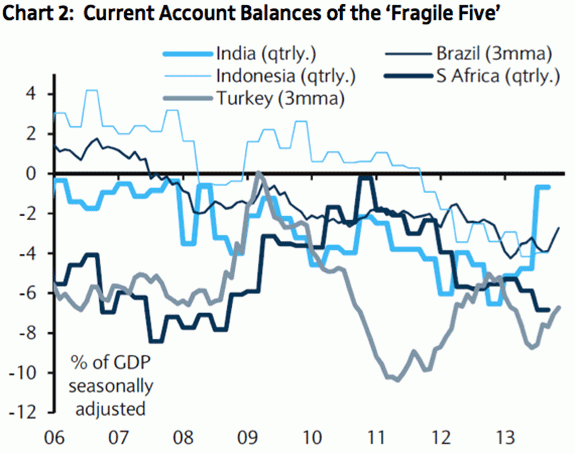
Source: Barclays Research, Haver Analytics
The United States provides liquidity to the rest of the world through two channels, one of which is well understood whilst the other one is not. Extraordinarily expansive monetary policy in the U.S. in recent years has provided a surge of private capital flowing towards EM economies. This is now in danger of reversing (chart 3).
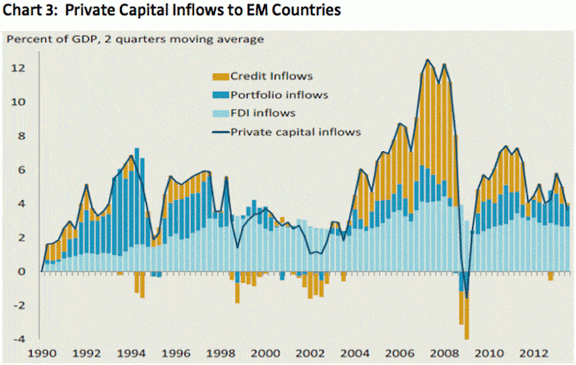
Source: World Bank
The World Bank has made a valiant effort to estimate the effect of QE on capital flows and have found that over 60% of all capital inflows to EM countries can be either directly or indirectly attributed to QE (chart 4). No wonder one or two EM central bank chiefs are looking slightly unsettled at the moment.

Source: World Bank
The other channel through which the U.S. provides liquidity to the rest of the world is its chronic current account deficit. Every dollar of deficit in the U.S. is by definition somebody else's surplus, so when the U.S current account deficit narrows, fewer dollars find their way to other countries. History is littered with examples of deteriorating U.S. dollar liquidity leading to a crisis somewhere, even if it is not always entirely predictable where and when it happens.
The U.S. economy is experiencing a true boom in domestic oil and gas production. In pre-crisis times, the U.S. would import the equivalent of 10-11 million barrels of oil per day (mbpd) to meet its demands. That has now dropped to 7-8 mbpd as a result of rapidly rising domestic production levels. Going into the 2008-09 recession, the U.S ran a quarterly deficit of about $200 billion. As a result of the deep recession, the quarterly deficit fell to less than $100 billion. Now, as the U.S. economy is doing better, one would have expected the deficit to deteriorate again, but it isn't happening (chart 5). Increased domestic oil and gas production is the key reason behind this, and the trend is likely to continue for years to come.
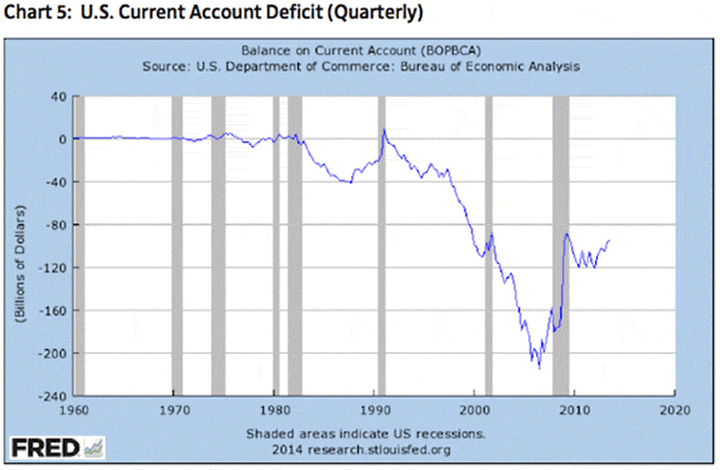
Source: Federal Reserve Bank of St. Louis
Stage one of the EM crisis was a relatively contained crisis, limited to a handful of countries with large current account deficits. Stage two, which began in earnest early in the New Year, has engulfed other countries such as Argentina, Chile and Russia. The crisis is manifesting itself in two ways – higher interest rates and deteriorating foreign exchange rates. A recent article in the FT made a very good point about how falling exchange rates pose yet another set of problems for many EM economies many of which heavily subsidise fuel costs. As their currency falls in value, the fuel price soars when measured in local currency (see here), putting further pressure on already stretched government budgets.
All of this has the potential to escalate into a full-blown EM crisis like the one we experienced in 1997-98, even if most EM countries are in much better shape today than they were going into the previous crisis. Remember, there is never only one cockroach! Should this happen (and I am not yet saying it definitely will happen), there will be significant private sector capital outflows from emerging markets seeking refuge in safe(r) havens, like T-bonds, bunds and gilts.
Then there is the ultimate joker, better known as the People's Republic of China. The debt problems in China are massive, and the probability of a hard landing uncomfortably high. According to Morgan Stanley, no less than 45% of all private debt in China must be refinanced in the next 12 months. It appears that the Chinese leadership has finally begun to confront the problems. I have no particular insight into how well that process is managed but I feel obliged to remind you that debt bubbles rarely have happy endings.
The Eurozone crisis re-ignites
The problems in mainland Europe are well advertised and I see no need to repeat them all here. Suffice to say that the Eurozone banking system continues to be seriously under-capitalised. The ECB recognises this and has published a preliminary list of 124 Eurozone banks that it will subject to an Asset Quality Review (AQR) later this year. The market seems to expect a shortfall of tier one capital of around €500 billion; however, a recent study conducted by two academics on behalf of CEPS (see here) suggests that the actual number will be much higher – at the order of €750-800 billion (chart 6).
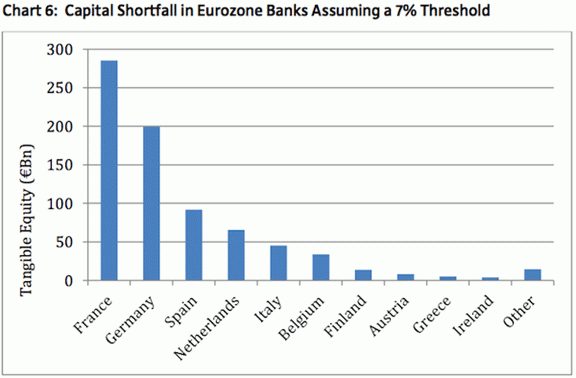
Source: CEPS Policy Brief
The French have, unlike some of their Latin neighbours, managed to escape the worst of the storms in recent years, but this may change soon, provided the analysis above is correct. €280 billion in new capital is an awful lot of money, even for the French, and President Hollande may soon have bigger issues than his private affairs to deal with.
Could the AQR re-ignite the crisis and de-rail all the good work of the last couple of years? It could, but it is not my base case. A central problem in the early days of Europe's fight against crisis was the perceived lack of a lender of last resort. Then, in the summer of 2012, Super Mario gave his famous 'Whatever it Takes' speech, and the markets haven't looked back since. Draghi, without spending a penny, single-handedly managed to persuade investors that the ECB is indeed the de- facto lender of last resort, even if officials continue to avoid using the term when referring to the ECB.
Having said that, the very public debate that is likely to follow the publication of the AQR could very well lead to a renewed widening of yield spreads between perceived safe havens and the crisis countries. This is my second reason why bond yields in the U.S., U.K. and Germany could actually fall in 2014.
The disinflationary trend intensifies and potentially turns into deflation
A more likely consequence of the 2014 AQR is sustained pressure on lending activities across the Eurozone, a trend which is already underway. Most banks in the Eurozone have seen the writing on the wall and are already preparing for higher capital standards. Of the larger countries, only in France does the penny not seem to have dropped yet (chart 7).
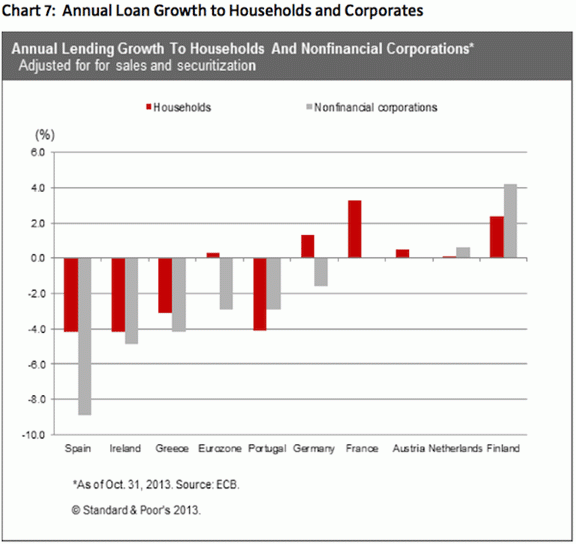
Source: Standard & Poors
The Eurozone is probably only one shock away from outright deflation. Consumer price inflation is running at 0.7% year-on-year, and that number is inflated by austerity driven tax hikes. According to Ambrose Evans-Pritchard, if those tax rises are stripped out, then (and I quote) "Italy, Spain, Holland, Portugal, Greece, Estonia, Slovenia, Slovakia, Latvia, as well as euro-pegged Denmark, Hungary, Bulgaria and Lithuania have all been in outright deflation since May [...]. Underlying prices have been dropping in Poland and the Czech Republic since July, and France since August." Not good. The inflation trend is unequivocally down and there is nothing to suggest that it is about to change (chart 8).
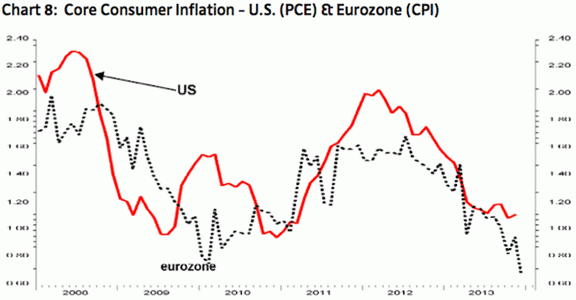
Source: Societe Generale Cross Asset Research
The one shock that would take the Eurozone into deflationary territory could indeed come from an escalation of the EM crisis, or it could come from somewhere few consider to be an issue right now – oil prices. I referred earlier to rising production volumes in the United States. A similar trend is to be expected from OPEC with both Libya and Iran (and possibly also Iraq) anticipating a significant increase in production levels, possibly as much as 3 mbpd between the two countries. If this happens at a time where much of the world is struggling to fire on all cylinders, oil prices could experience a significant drop.
The risk of outright deflation is much lower in the U.K. and U.S. than it is in the Eurozone. The U.K. is notoriously inflation-prone; however, more recently it has benefitted from a period of extraordinarily low growth in wages which will almost certainly not persist, if the economy continues to grow at the current rate. At the same time, the currency has a significant impact on UK inflation. When sterling is weak, inflation accelerates and vice versa. The recent strength of sterling has undoubtedly suppressed U.K. inflation to levels that are not consistent with current economic activity.
Underlying inflation is probably softer in the U.S. than it is in the U.K. but to suggest that the U.S. is on the verge of outright deflation seems to me to be a step too far. U.S. inflation has benefitted from a considerable amount of labour market slack in recent years but, if a recent study from Barclays Research is to be believed, that is about to change (chart 9).
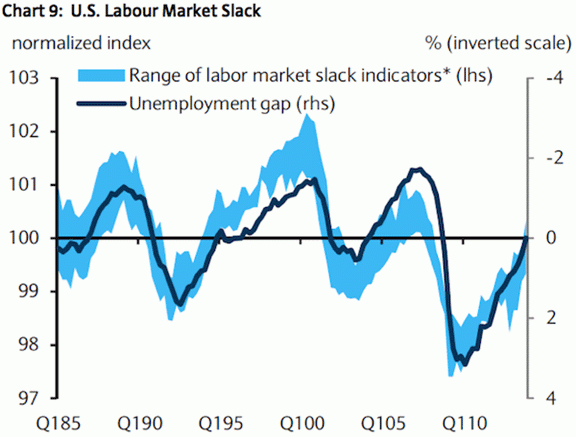
Source: Barclays Research
On the other hand, those who expect QE to ultimately lead to a dramatic rise in inflation rates are likely to be thoroughly disappointed. We are still in the early stages of deleveraging, following the bust of a massive credit cycle (chart 10). Disinflation, or perhaps even deflation, is the natural consequence of such deleveraging – not inflation. Any risk to our central forecast that bond yields will remain largely unchanged in 2014 is thus to the downside (as in yields going down, not up).
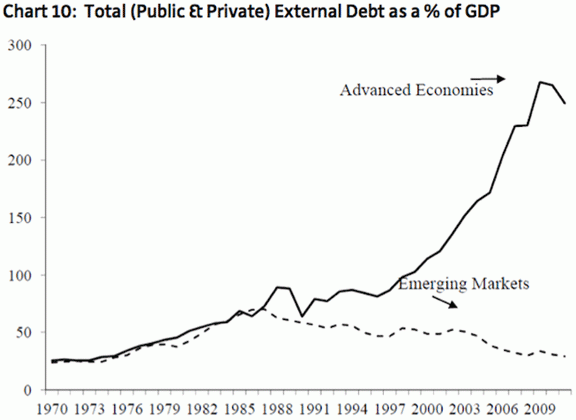
Source: Reinhart & Rogoff, IMF Working Paper
The economic recovery currently underway proves unsustainable
U.S. economic indicators have been mixed recently. Home sales, auto sales and capital goods orders have all shown signs of weakness. It may be no more than a wobble or it may be signs of a turning point in the economy but, as Frank Veneroso states: "The U.S. economy almost never grows above trend without participation from these three cyclical sectors: autos, capex, and housing."
Veneroso goes further in his analysis and makes a very interesting point:
You have to mistrust all the economic data. Why? BECAUSE AT TURNING POINTS IT IS ALWAYS WRONG. Ninety percent of all economic forecasters do not recognize a recession because the preliminary data always says there is no recession. It is only later that the data is revised to show a recession. After having failed to correctly forecast the economy for decades, Alan Greenspan late in his tenure as Fed Chairman realized why: he told us then that there is so much extrapolation in the preliminary economic data it can never reflect important cyclical changes. Economists never tell you this, because to do so would be tantamount to saying that if they forecast the upcoming data correctly they will be wrong about the underlying reality since it is always greatly revised at turning points. If this truth was well advertised, those who pay for their bogus forecasting exercise might not pay them as much – or at all." Frank Veneroso: "U.S. Economy – Will the Fed Taper $10 Billion?"
Gavyn Davies takes a more sanguine position:
There have been some mildly disappointing data releases in the US, but these have been mostly due to an excessive build-up in manufacturing inventories since mid-2013, and the prospects for final demand seem firm. Gavyn Davies: http://blogs.ft.com/gavyndavies/2014/02/02/the-ems-fragile-8-must-save-themselves
We will have to wait and see who is right and who is wrong; however, I don't particular like the quality of recent corporate earnings reports. Even to the untrained eye it is pretty obvious that many companies are struggling to deliver the earnings growth expected of them. Massive buyback programmes are used to generate EPS growth, but underlying sales and profits growth is dismal. This cannot go on forever. Given this and all the other factors conspiring against economic growth, the risk to our central forecast is very much on the downside.
Flow of funds provides more support for bonds than anticipated
Now to the fifth and final reason why the bond market could confound everyone this year and deliver positive rather than negative returns – flow of funds. Bond mutual funds hold record high levels of cash (chart 11), supposedly prepared for a sell-off in bonds, but with plenty of dry powder to step in and ultimately provide support, should the anticipated sell-off materialise.
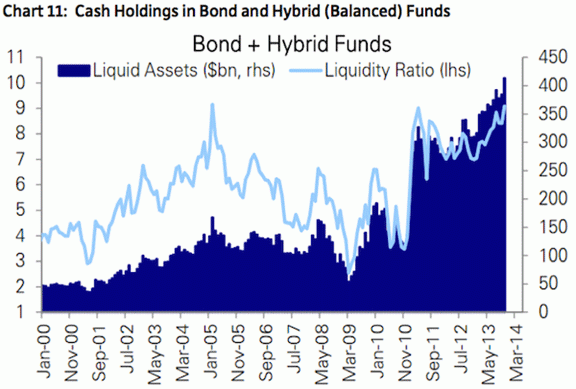
Source: Deutsche Bank
Secondly, U.S. pension funds have had a very strong year on the back of the powerful equity rally and, as a result, have increased the average funding ratio to 92% (http://www.businessinsurance.com/article/20131107/NEWS03/131109861?tags=|307|77|82). Such funding level was not expected to be reached until 2017 at the earliest, and the fact that the industry is several years ahead of its own recovery plan could very well mean that many pension funds decide to take some risk off the table in 2014 and move their funds into what is perceived to be a safer asset class – namely bonds.
Thirdly, foreign investors are often considered to be a risk factor when it comes to the outlook for U.S. bond yields and thus, by default, for bond yields in other developed markets as well (due to the high correlation between bond markets in most developed countries). Such views are often expressed in complete disregard of national accounting identities. The rest of the world's claims on the United States must equal the sum of all prior U.S. current account deficits. The rest of the world doesn't have to hold U.S. T-bonds but they must hold U.S. assets of some kind.
So, if we know that the U.S. economy will produce a current account deficit of $400 billion or so in 2014, we know that foreign claims on the U.S. will rise by $400 billion. From decades of experience, we also know that the vast majority of such claims will be placed in highly liquid instruments such as Treasuries. Foreigners now own near 50% of all Treasuries outstanding (chart 12). Most importantly, and the point missed by many, we know that the rest of the world simply cannot sell U.S. assets, even if they wanted to!
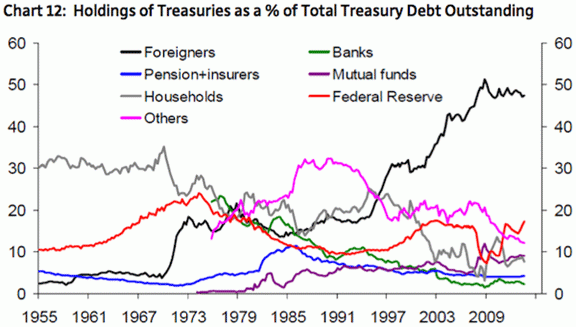
Source: Deutsche Bank
Conclusion
For all these reasons I am not at all convinced that 2014 will be the year where the bond market finally breaks down, but I have saved my trump card for last. I was recently introduced to a bond research firm called Applied Global Macro Research (www.appliedglobalmacrresearch.com). Started by Jason Benderly, who is an ex- colleague of mine from my days at Goldman Sachs and with a strong Danish line- up (Carsten Valgreen and Niels Bjørn both of whom came from senior positions at Danske Bank), I am embarrassed to admit that I haven't paid attention to them until recently when a good friend forwarded a research paper called 'The Year of the U.S. Curve Flattener', authored by Carsten.
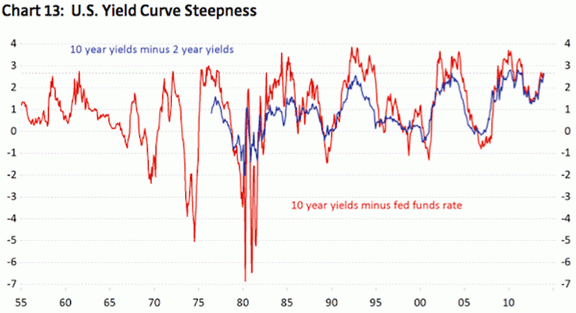
Source: Applied Global Macro Research
Applied Global Macro Research is a quant shop. The smart guys working there have built several interesting models, but the one catching my attention is a model designed to identify the basic drivers of 10-year T-bond yields. The research is highly proprietary, so I am not going to give everything away, but suffice to say that the model explains about 70% of the change in the 10-year yield over time. However, it is when you make some assumptions about the three underlying factors that the story becomes really interesting. Even in a strong economic environment, the model suggests that the total return on 10-year T-bonds in 2014 will be close to zero. Yields rise modestly in that scenario, but the carry will almost fully offset those losses. On the other hand, should the U.S. economy actually weaken, 10-year T-bonds should generate very attractive returns.
This asymmetry in expected returns is largely a function of the historically high spread between U.S. 2-year and 10-year Treasuries (the blue line in chart 13 above). On that basis, the smart trade appears to be a spread trade – long 10-year vs. short 2-year Treasuries – rather than an outright short at the long end. For this and all the other reasons mentioned above, I cannot be bearish on bonds, be it U.S. or European.
Niels C. JensenLike Outside the Box?
Sign up today and get each new issue delivered free to your inbox.
It's your opportunity to get the news John Mauldin thinks matters most to your finances.
© 2013 Mauldin Economics. All Rights Reserved.
Outside the Box is a free weekly economic e-letter by best-selling author and renowned financial expert, John Mauldin. You can learn more and get your free subscription by visiting www.MauldinEconomics.com.
Please write to subscribers@mauldineconomics.com to inform us of any reproductions, including when and where copy will be reproduced. You must keep the letter intact, from introduction to disclaimers. If you would like to quote brief portions only, please reference www.MauldinEconomics.com.
To subscribe to John Mauldin's e-letter, please click here: http://www.mauldineconomics.com/subscribe
To change your email address, please click here: http://www.mauldineconomics.com/change-address
Outside the Box and MauldinEconomics.com is not an offering for any investment. It represents only the opinions of John Mauldin and those that he interviews. Any views expressed are provided for information purposes only and should not be construed in any way as an offer, an endorsement, or inducement to invest and is not in any way a testimony of, or associated with, Mauldin's other firms. John Mauldin is the Chairman of Mauldin Economics, LLC. He also is the President of Millennium Wave Advisors, LLC (MWA) which is an investment advisory firm registered with multiple states, President and registered representative of Millennium Wave Securities, LLC, (MWS) member FINRA, SIPC, through which securities may be offered . MWS is also a Commodity Pool Operator (CPO) and a Commodity Trading Advisor (CTA) registered with the CFTC, as well as an Introducing Broker (IB) and NFA Member. Millennium Wave Investments is a dba of MWA LLC and MWS LLC. This message may contain information that is confidential or privileged and is intended only for the individual or entity named above and does not constitute an offer for or advice about any alternative investment product. Such advice can only be made when accompanied by a prospectus or similar offering document. Past performance is not indicative of future performance. Please make sure to review important disclosures at the end of each article. Mauldin companies may have a marketing relationship with products and services mentioned in this letter for a fee.
Note: Joining The Mauldin Circle is not an offering for any investment. It represents only the opinions of John Mauldin and Millennium Wave Investments. It is intended solely for investors who have registered with Millennium Wave Investments and its partners at http://www.MauldinCircle.com (formerly AccreditedInvestor.ws) or directly related websites. The Mauldin Circle may send out material that is provided on a confidential basis, and subscribers to the Mauldin Circle are not to send this letter to anyone other than their professional investment counselors. Investors should discuss any investment with their personal investment counsel. You are advised to discuss with your financial advisers your investment options and whether any investment is suitable for your specific needs prior to making any investments. John Mauldin is the President of Millennium Wave Advisors, LLC (MWA), which is an investment advisory firm registered with multiple states. John Mauldin is a registered representative of Millennium Wave Securities, LLC, (MWS), an FINRA registered broker-dealer. MWS is also a Commodity Pool Operator (CPO) and a Commodity Trading Advisor (CTA) registered with the CFTC, as well as an Introducing Broker (IB). Millennium Wave Investments is a dba of MWA LLC and MWS LLC. Millennium Wave Investments cooperates in the consulting on and marketing of private and non-private investment offerings with other independent firms such as Altegris Investments; Capital Management Group; Absolute Return Partners, LLP; Fynn Capital; Nicola Wealth Management; and Plexus Asset Management. Investment offerings recommended by Mauldin may pay a portion of their fees to these independent firms, who will share 1/3 of those fees with MWS and thus with Mauldin. Any views expressed herein are provided for information purposes only and should not be construed in any way as an offer, an endorsement, or inducement to invest with any CTA, fund, or program mentioned here or elsewhere. Before seeking any advisor's services or making an investment in a fund, investors must read and examine thoroughly the respective disclosure document or offering memorandum. Since these firms and Mauldin receive fees from the funds they recommend/market, they only recommend/market products with which they have been able to negotiate fee arrangements.
PAST RESULTS ARE NOT INDICATIVE OF FUTURE RESULTS. THERE IS RISK OF LOSS AS WELL AS THE OPPORTUNITY FOR GAIN WHEN INVESTING IN MANAGED FUNDS. WHEN CONSIDERING ALTERNATIVE INVESTMENTS, INCLUDING HEDGE FUNDS, YOU SHOULD CONSIDER VARIOUS RISKS INCLUDING THE FACT THAT SOME PRODUCTS: OFTEN ENGAGE IN LEVERAGING AND OTHER SPECULATIVE INVESTMENT PRACTICES THAT MAY INCREASE THE RISK OF INVESTMENT LOSS, CAN BE ILLIQUID, ARE NOT REQUIRED TO PROVIDE PERIODIC PRICING OR VALUATION INFORMATION TO INVESTORS, MAY INVOLVE COMPLEX TAX STRUCTURES AND DELAYS IN DISTRIBUTING IMPORTANT TAX INFORMATION, ARE NOT SUBJECT TO THE SAME REGULATORY REQUIREMENTS AS MUTUAL FUNDS, OFTEN CHARGE HIGH FEES, AND IN MANY CASES THE UNDERLYING INVESTMENTS ARE NOT TRANSPARENT AND ARE KNOWN ONLY TO THE INVESTMENT MANAGER. Alternative investment performance can be volatile. An investor could lose all or a substantial amount of his or her investment. Often, alternative investment fund and account managers have total trading authority over their funds or accounts; the use of a single advisor applying generally similar trading programs could mean lack of diversification and, consequently, higher risk. There is often no secondary market for an investor’s interest in alternative investments, and none is expected to develop.
John Mauldin Archive |
© 2005-2022 http://www.MarketOracle.co.uk - The Market Oracle is a FREE Daily Financial Markets Analysis & Forecasting online publication.



